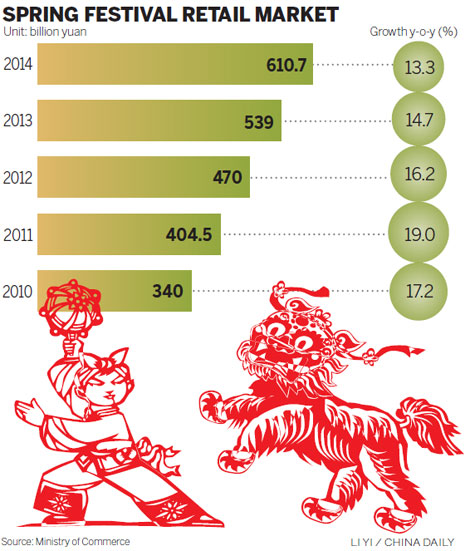
High-end catering was eschewed during festival gatherings but that did not affect more ordinary dining. The operational revenues of popular catering businesses increased about 20 percent year-on-year from Anhui province to the Guangxi Zhuang autonomous region. The turnover of surveyed high-end restaurants dropped more than 20 percent in Heilongjiang province, according to the ministry.
More spending on recreational, tourism, cultural and educational activities as well as entertainment and bodybuilding has become a new highlight of the holiday. The capital city of Beijing earned 4.384 billion yuan in tourism income during the holiday week, up 13 percent from the same period last year. It welcomed an estimated 9.75 million sightseers, up 12.3 percent year-on-year, said the Beijing Municipal Commission of Tourism Development on Thursday.
Cinemas across the country reeled in 1.4 billion yuan during the holiday, up 86 percent year-on-year. The whole of January only generated about 1.9 billion yuan in box office takings, according to Tencent, a news portal. In addition, the number of moviegoers increased by 98 percent from the same dates in the previous year, amounting to 39 million yuan during the seven days.
"These new highlights will continue and shape consumption trends in the near future. But the government needs to improve the purchasing environment, such as better and more fitness and cultural facilities in communities, which will encourage the emerging spending models but also increase domestic demand," Huo said.
China's flourishing e-commerce facilitated the holiday expenditure as more people turned to online shopping for railway tickets and goods celebrating the festival. Instant messaging systems such as WeChat and QQ, which are relatively new vehicles to express New Year wishes, greatly increased information-related use, according to the ministry.
In contrast, the fever for sending greetings via short text or multimedia messages to relatives and friends cooled during the festival, according to figures from provincial telecom companies.
China Mobile's Tianjin subsidiary said it recorded 245 million mobile phone messages on Lunar New Year's Eve this year, down by 12.5 percent year-on-year. In Shaoxing, a city in Zhejiang province, the number of messages sent on Lunar New Year's Eve decreased by 21 percent year-on-year.
China's three telecom carriers did not disclose their nationwide figures for such messages during Spring Festival this year. But industry insiders expect the total number of short text messages to have dropped by 10 percent and multimedia messages by 20 percent from the same holiday period during the previous year.
Overall, eastern areas witnessed a more significant drop than middle and western regions. That is because eastern regions are usually equipped with faster, more advanced mobile networks. The younger generations in those areas tended to use instant-messaging tools, such as WeChat, to send their New Year greetings.
On Lunar New Year's Eve 2013, China Mobile, the country's biggest telecom carrier, serviced 9.1 billion text messages, an increase of 3 percent year-on-year. The company also carried more than 250 million multimedia messages, up 18 percent from the same period a year earlier.
Shen Jingting contributed to this story.
|